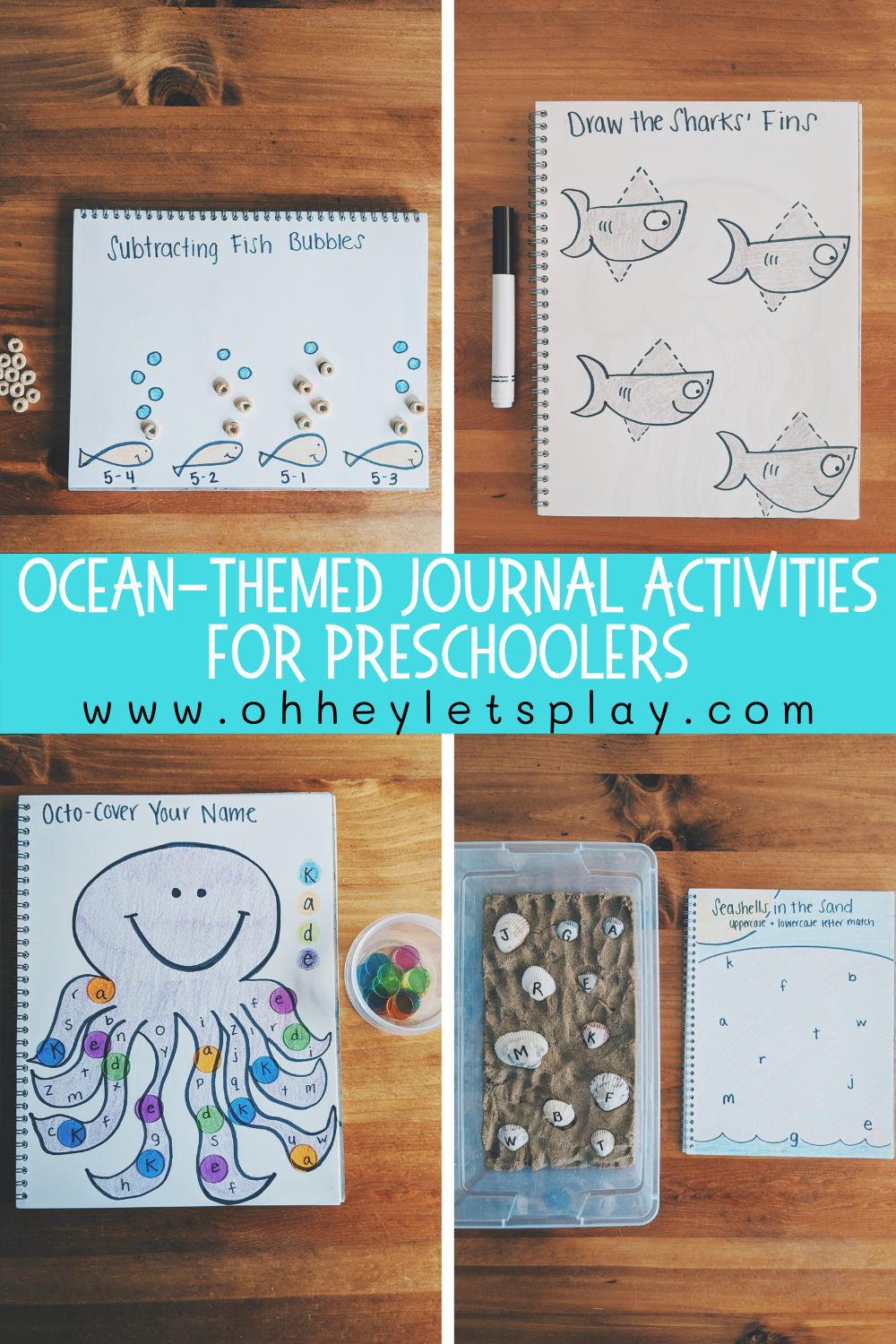Ocean-Themed Journal Activities for Preschoolers
Ocean-theme was such a fun one for journal pages this week! I’m not sure if I had more fun creating all the pages, or if Kade (age 4) had more fun actually completing each page. Journaling like this with your kiddos is a great way to spend quality time playing and learning together and it has been such an engaging way to practice different skills.
For more information about learning journals and how to start one, check out this post!
I have 8 hands-on, play-based journal activities to share with you in this post and hope that at least one of them inspires you toward playing and learning at home with your own kiddo(s)! I always try to share a couple of ideas for different variations of each activity as well depending on the age of your little ones. If you end up liking these activities, be sure to check out our zoo-themed journal activities, too!
Disclaimer: This post contains affiliate links which means I would earn a small commission if you were to purchase through those links. All opinions are my own, and I only link to products that I truly recommend.
Counting Fish Bubbles:
Here is a great way to practice counting, number identification and one-to-one correspondence (the skill of being able to match/connect one single object or element to one single number at a time). To set this activity up, I simply drew three (you could turn the journal horizontal and fit more) fish across the bottom of the page each with a different number on them. I chose numbers that I know Kade tends to get mixed up (6 and 8) in terms of recognizing. I also knew I couldn’t choose too big of a number because we would only be able to fit so many “bubbles” on the page.
I used a black marker and some crayons to create the journal page, and all Kade needed to complete it was a blue do-a-dot marker. Whenever we do an activity with do-a-dot markers, I typically have to slide another piece of paper behind the one we are using since they sometimes bleed through the paper. If you are looking for a journal with more space, and thicker pages that won’t bleed, I recommend this one (we have it and will be using it as soon as our current one is out of pages).
Draw the Jellyfish Legs
It is so crazy and interesting to me the difference between fine motor skills in a boy versus a girl- all the way down to gripping a utensil. This may not ring true for all boys and girls, but for my boy and girl it does for sure. I have loved watching the two of them and how they have mastered different skills at different times of their little lives. For our daughter Tatum (2), a grip on a utensil (crayon, pencil, marker, etc.) is a no brainer. For Kade (4), he was talking in full sentences by about 18 months and is sharp as a tac but still struggles with a proper grip. I’m not worried (and you shouldn’t either if you’re in the same boat with your little one) because I know there is plenty of time for him to develop in this area but we do try to work on it whenever we get the chance.
Aside from things like playing with play doh, and manipulating small materials such as wiki stix, pipe cleaners, threading beads, etc. (which are honestly the MAIN ways we should be working on developing these skills at this age), doing the occasional pre-writing activity where kiddos actually get to practice gripping a writing utensil, is a great way to also improve on these skills.
To prep this activity, I drew a big ole jelly fish (in pencil first, with a large eraser handy- because artistry and drawing are not my greatest talents), and added dashed lines on each of its legs for Kade to trace. Knowing how to trace on a dotted/dashed line is something that will benefit kiddos to know about come time for kindergarten. All Kade needed to complete this activity was a black marker- so simple, fun, and effective!
Seashells in the Sand:
For this activity, we were working on identifying letters, and then matching uppercase and lowercase. We have a stash of seashells that we’ve collected from either our own beach trips or people bringing them back for us from their beach trips. At first I always think we are crazy for holding onto them but then the kids end up randomly playing with them and I end up finding fun uses for them like this and I feel better about my seashell hoarding self. If you don’t have seashells hoarded, you can just order some here. :)
I picked out a handful of our shells and used masking tape and a sharpie to write uppercase letters on them. The seashells went into a bin with kinetic sand- one of our favorite sensory play materials. I drew a beach scene in Kade’s journal and wrote coordinating lowercase letters in the “sand.” He would find a shell in the bin, say the letter, and then find the matching lowercase letter in his journal and cover it with the shell.
After the first few letters he wanted to close his eyes and have me actually hide/bury the shells in the sand so that he could dig for them which was way more fun than when I had just set them in there. I so appreciated that he was up for extending the play and making it more of a challenge. ;) You could do this activity with the letters in your kiddos’ names, matching numbers and amounts (or just numbers), simple addition, sight words, or colors/shapes for younger kiddos.
Subtracting Fish Bubbles:
This was a last minute idea I had when I knew snack time was coming up and realized that cheerios kind of resembled fish bubbles. Involving food is a great way to get kiddos engaged in their learning. Using it to introduce subtraction is especially enticing because they physically need to take things away AKA EAT THE FOOD.
Setting this activity up was super simple and very similar to the “Counting Fish Bubbles” activity. I drew a few fish along the bottom of the journal and wrote simple subtraction problems below each fish. We have only done subtraction one other time so we took a few minutes to talk about the “minus” symbol and how it means to subtract or “take away.” We talked about how the first number is always the number of how many you START with, and the second number is how many you’re taking away.
I decided to have each problem start with 5 just to keep things consistent. Each problem required a different number to be taken away. I had Kade place a cheerio on each of the 5 bubbles before starting each problem, and then he had to tell me how many he needed to take away. His favorite part, of course, was then eating that many bubbles/cheerios, and telling me how many were left over. If you want a more healthy approach, use blueberries! If you want a less healthy approach, use blue m&ms. :)
Drawing Shark Fins:
Here’s another fun pre-writing activity - and yes - I had to google “how to draw a simple shark” before prepping this page. We talked about how drawing the top fin of each shark was similar to how you would write an uppercase “A,” and the bottom fin of each shark is how you would write the letter “v.” Typically, straight vertical and horizontal lines are easiest for kiddos to master when first learning to write, and diagonals come a little later on so we are just trying to sprinkle a few of them in here and there.
Notice that grip on the marker… I told you- we’re working on it. ;) Sometimes I correct his grip, and honestly, sometimes I don’t. This is an area that is difficult for him and he puts a lot of pressure on himself to stay on the lines. I try to encourage him for doing his best more so than correcting what I see. He will become more comfortable with a proper grip as time goes on and the more we work on it.
Octo-Cover Your Name:
Lots of different variations you could do for this activity! I chose the letters in Kade’s name- because he still sometimes gets lowercase “a” and “e” confused. I made a special color code over on the side of the page so he knew which color to cover each letter that he found. You could have kiddos covering shapes certain colors, numbers, names, sight words, or you could have them roll a dice and cover numbers that way (without a color code).
I love using these colorful bingo chips for activities like this. You could also cover with pom poms, do-a-dot markers, cheerios, dot stickers, or even just color on top of them with crayon.
Kiddos are working on hand-eye coordination by covering a letter (or whatever you choose to focus on), while also practicing identification, and color matching. So that Kade wasn’t overwhelmed trying to look for each letter, we took things one leg at a time. I had him start on the left and work toward the right, starting with looking for the letter “K.” He would check the code to see what color he needed to use, and then search each leg, from left to right, for the letter “K" covering them as he found them. Then we would move on to the next letter and do the same thing!
Beach Umbrella Number Match:
I can’t take credit for this one! This was all my friend Theresa- she seriously comes up with the best journal pages ever and I’m always so inspired by her. She did a few ocean/beach-themed pages recently and this was one she had in her set. I believe she called it “Cover the Beach Towel” or something to that effect.
I actually had a lot of fun drawing and coloring this one. I drew a little beach towel with a matching beach umbrella for each number. We have these dominoes and love them- the colors are so fun and they come in the cutest little wooden box! I picked out a few that went along with the numbers I wanted to work on and Kade had to count the dots on each domino then find the matching number.
Not only does this activity work on number recognition, counting, and one-to-one correspondence, but it also covers simple addition and subitizing. That last word is super math-y but it just means being able to look at a group and know how much is there without counting (for example: rolling a “6” on a dice but knowing it’s 6 by just looking at it and not having to count). Dominoes and dice are great ways to practice that skill because the dots are laid out in a similar fashion so kiddos get used to seeing them and knowing how many there are. Depending on where your child, or students, are at with counting you could choose to use dominoes with fewer dots, or more dots.
Roll and Feed the Shark:
Speaking of using dice… and food… here we are! Like I said for the last activity, counting activities with dice and dominoes are beneficial because kiddos get used to seeing the amounts and knowing which number they represent. When we play a game and roll a 5, we don’t need to count each dot to know we rolled a 5. I also mentioned earlier how much fun learning can be when you incorporate food. I love doing activities like this when it’s a typical snack time so that we can kind of kill two birds with one stone.
To set up this activity, I drew a giant shark head with an open mouth. I tried to make him look friendly rather than frightening. ;) Kade would roll the dice and feed the shark the appropriate number of goldfish. After feeding them to the shark, he got to feed them to himself. If your kiddo is ready to roll TWO dice, add another one, roll them both, count them up, and make sure you drew a bigger mouth than the one I drew. ;)
To access my digital learning journal guides with all my learning journal activity ideas organized by age group, check out my Digital Learning Journal Membership!
A "learning journal" is a blank sketchbook that is used to hand draw & personalize learning activities for your child based on different developmental skills. This membership makes your learning journal experience a breeze by providing you with a digital toddler, preschool, kindergarten, & early elementary aged journal activity guide. The 4 guides are organized by developmentally appropriate, seasonal & non-seasonal activities, & are frequently updated with new ideas.
Ocean week has been SO fun and SO full of great play-based learning opportunities that we extended it into two weeks. I rounded up all of our ocean-themed fun into one big post that you can check out HERE. If you enjoy a good play theme as much as we do, check out our other themed activity posts:
Zoo Activities
Bug Activities
Frog Activities
Apple Activities

























